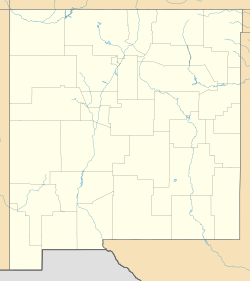Pinos Altos, New Mexico facts for kids
Quick facts for kids
Pinos Altos, New Mexico
|
|
|---|---|
| Country | United States |
| State | New Mexico |
| County | Grant |
| Area | |
| • Total | 0.76 sq mi (1.96 km2) |
| • Land | 0.76 sq mi (1.96 km2) |
| • Water | 0.00 sq mi (0.00 km2) |
| Elevation | 6,985 ft (2,129 m) |
| Population
(2020)
|
|
| • Total | 225 |
| • Density | 297.62/sq mi (114.85/km2) |
| Time zone | UTC-7 (Mountain (MST)) |
| • Summer (DST) | UTC-6 (MDT) |
| ZIP code |
88053
|
| Area code(s) | 575 |
| GNIS feature ID | 2584179 |
Pinos Altos is a small community in Grant County, New Mexico, United States. It is known as a census-designated place, which is a special area defined for population counting. The town started as a mining town in 1860. This was after gold was found in the nearby Pinos Altos Mountains.
Pinos Altos is located about five to ten miles north of Silver City. Even though it was once empty, the town is now a popular spot for summer homes. Many tourists also visit Pinos Altos. In 2020, its population was 225 people.
Contents
History of Pinos Altos
Early Beginnings and Gold Discovery
Pinos Altos was first called Birchville. It was named after Robert H. Birch, a prospector who found the first gold. He was one of three people who made this important discovery. Later, the town got its Spanish name, Pinos Altos. This means "tall pines" because many tall trees grew there.
The town grew quickly after gold was found. By the 1880s and 1890s, about 9,000 people lived there. The tall pine trees were cut down as the town expanded. However, Pinos Altos slowly became empty in the early 1900s. Today, many of the original buildings from that time are still standing.
Conflicts with Native Americans
From 1860 to late 1861, miners faced challenges from Apache Native Americans. The Apache people did not want American and Mexican settlers on their lands. On September 27, 1861, a battle took place in Pinos Altos. It was between the Arizona Guards, a local militia, and Apache warriors. These warriors were led by famous chiefs Mangas Coloradas and Cochise.
This battle did not end the fighting between settlers and Native Americans. The conflict continued for several years. Neither side was very willing to find a peaceful solution. Even when a peace agreement was discussed, conflicts still happened. This showed how difficult it was to resolve these disputes. The fighting continued until the military built permanent forts in the area. Fort Bayard, built in 1866, was one of the most important forts.
Mining and Railroad Development
Senator George Hearst invested in several mines in Pinos Altos. These included the Mina Grande and the Pacific Mine. In 1889, he built a stamp mill in Pinos Altos. A stamp mill is a machine that crushes ore to get out the valuable minerals.
Hearst also started the Silver City, Pinos Altos and Mogollon Railroad. This railroad was built to connect his mines to his smelter in Silver City. A smelter is a place where metal is extracted from ore using heat. The Comanche Mining and Smelting Company finished this narrow-gauge railroad in 1906. A narrow-gauge railroad has tracks that are closer together than standard tracks. However, the railroad closed the next year when the price of copper dropped.
Today, the old opera house in Pinos Altos has been combined with the Buckhorn Saloon. It now serves as a restaurant.
Demographics
Pinos Altos is a small community. Here is its population from the latest census:
| Historical population | |||
|---|---|---|---|
| Census | Pop. | %± | |
| 2020 | 225 | — | |
| U.S. Decennial Census | |||
See also
 In Spanish: Pinos Altos (Nuevo México) para niños
In Spanish: Pinos Altos (Nuevo México) para niños



